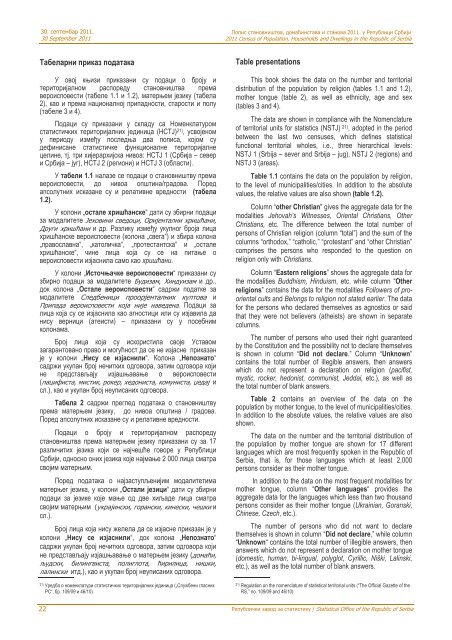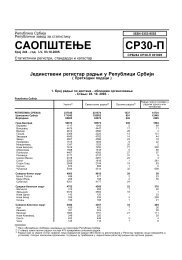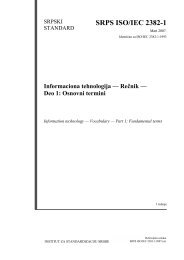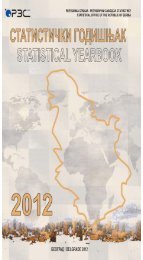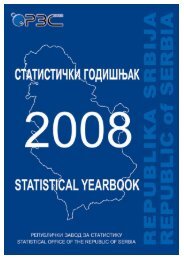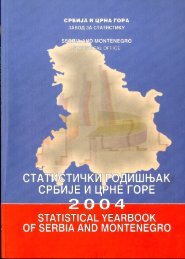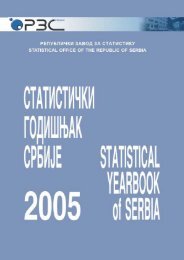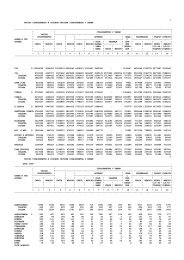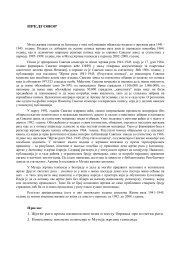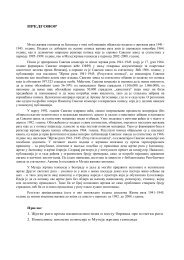Попис становништва, домаћинстава и станова 2011. у Републици Србији2011 Census of Population, Households <strong>and</strong> Dwellings in the Republic of Serbia30. септембар 2011.30 September 2011У табели А3 прика<strong>за</strong>н је упоредни прегледстановништва по националној припадности, по пописима од1948. до 2011. године, <strong>за</strong> најбројније етничке <strong>за</strong>једницепрема резултатима Пописа 2011. године (видети напоменуна страни 12).Table А3 shows a comparative overview of the populationby <strong>ethnicity</strong>, as per the censuses from 1948 to 2011, for themost numerous ethnic communities according to the results ofthe 2011 Census (see the remark on page 12).Табела A3. Становништво према националној припадности, по пописима 1948–2011.Table A3. Population by <strong>ethnicity</strong>, as per the 1948–2011 censuses1948 1953 1961 1971 1981 1991 14) 2002 2011РЕПУБЛИКА СРБИЈА / REPUBLIC OF SERBIA 6527966 6979154 7642227 8446591 9313676 7822795 7498001 7186862Срби / Serbs 4823730 5152939 5704686 6016811 6182155 6252405 6212838 5988150Албанци 15) / Albanians 15) 532011 565513 699772 984761 1303034 78281 61647 5809Бошњаци / Bosniaks - - - - - - 136087 145278Бугари / Bulgarians 59472 60146 58494 53800 33455 26698 20497 18543Буњевци 16) / Bunjevci 16) - - - - - 21434 20012 16706Власи / Vlachs 93440 28047 1368 14724 25596 17804 40054 35330Горанци / Goranci - - - - - - 4581 7767Југословени 17) / Yugoslavs 17) - - 20079 123824 441941 320168 80721 23303Мађари / Hungarians 433701 441907 449587 430314 390468 343800 293299 253899Македонци / Macedonians 17917 27277 36288 42675 48986 45068 25847 22755Муслимани 18) / Muslims 18) 17315 81081 93467 154330 215166 180222 19503 22301Немци / Germans 41460 46228 14533 9086 5302 5172 3901 4064Роми / Roma people 52181 58800 9826 49894 110959 94492 108193 147604Румуни / Romanians 63130 59705 59505 57419 53693 42316 34576 29332Руси / Russians 13329 7829 6984 4746 2761 2473 2588 3247Русини 19) / Ruthenians 19) 22667 23720 25658 20608 19757 18052 15905 14246Словаци / Slovaks 73140 75027 77837 76733 73207 66772 59021 52750Словенци / Slovenians 20998 20717 19957 15957 12006 8001 5104 4033Украјинци 19) / Ukrainians 19) … … … 5643 5520 5042 5354 4903Хрвати 16) / Croats 16) 169864 173246 196409 184913 149368 97344 70602 57900Црногорци / Montenegrins 74860 86061 104753 125260 147466 118934 69049 38527Остали / Other 18751 68917 57420 29924 34931 14800 13922 17558Нису се изјаснили / Did not declare - - - 4486 7834 10718 107732 160346Регионална припадност / Regional affiliation - - - 10409 6848 4841 11485 30771Непознато 20) / Unknown 20) … 1994 5604 30274 43223 47958 75483 8174014)За 1991. годину иска<strong>за</strong>ни су процењени подаци (процена је рађена само <strong>за</strong>општине Бујановац и Прешево јер се због бојкота Пописа од стране највећег делаалбанског становништва не располаже стварним подацима <strong>за</strong> ове општине).14)For 1991 estimated data were presented (estimates were worked out only for themunicipalities of Bujanovac <strong>and</strong> Preševo, since due to the boycott of the Census by themajority of the Albanian population, the actual data for these two municipalities are notavailable).15)За 2011. годину видети објашњења дата у Предговору.15)For 2011, see the explanations given in the Foreword.16)Све до Пописа 1991. године Буњевци (као и Шокци) приказивани су збирно са16)Up until the 1991 Census, the Bunjevci (as well as the Šokci) were shown collectivelyХрватима.with the Croats.17)У Попису 1961. године модалитет Југословени обухвата грађане Републике17)In the 1961 Census, the modality Yugoslavs included the citizens of the Republic ofСрбије који се нису ближе национално определили или су се определили у смислуSerbia who did not provide a closer <strong>ethnicity</strong> or have declared themselves in terms ofрегионалне припадности, док су у Попису 1971. први пут, као посебна група,regional affiliation, while the 1971 Census showed for the first time, as a separateиска<strong>за</strong>ни само грађани који су се изјаснили као Југословени, иако су сматраниgroup, solely the citizens who declared themselves as the Yugoslavs although theyлицима која се нису национално изјаснила.were considered as the persons who did not declare themselves ethnically.18)У Попису 1948. године модалитет у класификацији био је Неопредељени-Муслимани. У Попису 1953. модалитет је био Југословени-неопредељени иобухватао је збирно Муслимане и лица која су навела регионалну припадност(нпр. Шумадинац, Ера, Босанац итд.). У Попису 1961. године први пут се помињемодалитет Муслимани у смислу етничке припадности.18)In the 1948 Census, the modality in the classification was Undefined-Muslims. In the1953 Census, the modality was Yugoslavs-undefined <strong>and</strong> it included collectively theMuslims <strong>and</strong> the persons who stated their regional affiliation (e.g., Šumadinac, Era,Bosnian, etc.). The 1961 Census mentioned the modality Muslims in terms of <strong>ethnicity</strong>for the first time.19)До Пописа 1971. године збирно су иска<strong>за</strong>ни Русини и Украјинци.19)Until the 1971 Census, the Ruthenians <strong>and</strong> the Ukrainians were shown collectively.20)За 1948. годину Непознато је укључено у Остали.20)For the year 1948, Unknown is included in Other.<strong>Републички</strong> <strong><strong>за</strong>вод</strong> <strong>за</strong> статистику / Statistical Office of the Republic of Serbia 21
30. септембар 2011.30 September 2011Попис становништва, домаћинстава и станова 2011. у Републици Србији2011 Census of Population, Households <strong>and</strong> Dwellings in the Republic of SerbiaТабеларни приказ податакаУ овој књизи прика<strong>за</strong>ни су подаци о броју итериторијалном распореду становништва премавероисповести (табеле 1.1 и 1.2), матерњем језику (табела2), као и према националној припадности, старости и полу(табеле 3 и 4).Подаци су прика<strong>за</strong>ни у складу са Номенклатуромстатистичких територијалних јединица (НСТЈ) 21) , усвојеному периоду између последња два пописа, којом судефинисане статистичке функционалне територијалнецелине, тј. три хијерархијска нивоа: НСТЈ 1 (Србија – севери Србија – југ), НСТЈ 2 (региони) и НСТЈ 3 (области).У табели 1.1 налазе се подаци о становништву премавероисповести, до нивоа општина/градова. Поредапсолутних иска<strong>за</strong>не су и релативне вредности (табела1.2).У колони „остале хришћанске“ дати су збирни подаци<strong>за</strong> модалитете Јеховини сведоци, Оријентални хришћани,Други хришћани и др. Разлику између укупног броја лицахришћанске вероисповести (колона „свега“) и збира колона„православна“, „католичка“, „протестантска“ и „осталехришћанске“, чине лица која су се на питање овероисповести изјаснила само као хришћани.У колони „Источњачке вероисповести“ прика<strong>за</strong>ни сузбирно подаци <strong>за</strong> модалитете Буди<strong>за</strong>м, Хиндуи<strong>за</strong>м и др.,док колона „Остале вероисповести“ садржи податке <strong>за</strong>модалитете Следбеници проорјенталних култова иПрипада вероисповести која није наведена. Подаци <strong>за</strong>лица која су се изјаснила као агностици или су изјавила данису верници (атеисти) – прика<strong>за</strong>ни су у посебнимколонама.Број лица која су искористила своје Уставом<strong>за</strong>гарантовано право и могућност да се не изјасне прика<strong>за</strong>нје у колони „Нису се изјаснили“. Колона „Непознато“садржи укупан број нечитких одговора, <strong>за</strong>тим одговора којине представљају изјашњавање о вероисповести(пацифиста, мистик, рокер, хедониста, комуниста, џедај исл.), као и укупан број неуписаних одговора.Табела 2 садржи преглед података о становништвупрема матерњем језику, до нивоа општина / градова.Поред апсолутних иска<strong>за</strong>не су и релативне вредности.Подаци о броју и територијалном распоредустановништва према матерњем језику прика<strong>за</strong>ни су <strong>за</strong> 17различитих језика који се најчешће говоре у РепублициСрбији, односно оних језика које најмање 2 000 лица сматрасвојим матерњим.Поред података о нај<strong>за</strong>ступљенијим модалитетимаматерњег језика, у колони „Остали језици“ дати су збирниподаци <strong>за</strong> језике које мање од две хиљаде лица сматрасвојим матерњим (украјински, горански, кинески, чешк исл.).Број лица која нису желела да се изјасне прика<strong>за</strong>н је уколони „Нису се изјаснили“, док колона „Непознато“садржи укупан број нечитких одговора, <strong>за</strong>тим одговора којине представљају изјашњавање о матерњем језику (домаћи,људски, билингвиста, полиглота, ћирилица, нишки,лалински итд.), као и укупан број неуписаних одговора.21)Уредба о номенклатури статистичких територијалних јединица („Службени гласникРС“, бр. 109/09 и 46/10).Table presentationsThis book shows the data on the number <strong>and</strong> territorialdistribution of the population by <strong>religion</strong> (tables 1.1 <strong>and</strong> 1.2),<strong>mother</strong> <strong>tongue</strong> (table 2), as well as <strong>ethnicity</strong>, age <strong>and</strong> sex(tables 3 <strong>and</strong> 4).The data are shown in compliance with the Nomenclatureof territorial units for statistics (NSTJ) 21) , adopted in the periodbetween the last two censuses, which defines statisticalfunctional territorial wholes, i.e., three hierarchical levels:NSTJ 1 (Srbija – sever <strong>and</strong> Srbija – jug), NSTJ 2 (regions) <strong>and</strong>NSTJ 3 (areas).Table 1.1 contains the data on the population by <strong>religion</strong>,to the level of municipalities/cities. In addition to the absolutevalues, the relative values are also shown (table 1.2).Column “other Christian" gives the aggregate data for themodalities Jehovah’s Witnesses, Oriental Christians, OtherChristians, etc. The difference between the total number ofpersons of Christian <strong>religion</strong> (column “total”) <strong>and</strong> the sum of thecolumns “orthodox,” “catholic,” “protestant” <strong>and</strong> “other Christian”comprises the persons who responded to the question on<strong>religion</strong> only with Christians.Column “Eastern <strong>religion</strong>s” shows the aggregate data forthe modalities Buddhism, Hinduism, etc. while column “Other<strong>religion</strong>s” contains the data for the modalities Followers of proorientalcults <strong>and</strong> Belongs to <strong>religion</strong> not stated earlier. The datafor the persons who declared themselves as agnostics or saidthat they were not believers (atheists) are shown in separatecolumns.The number of persons who used their right guaranteedby the Constitution <strong>and</strong> the possibility not to declare themselvesis shown in column “Did not declare.” Column “Unknown”contains the total number of illegible answers, then answerswhich do not represent a declaration on <strong>religion</strong> (pacifist,mystic, rocker, hedonist, communist, Jeddai, etc.), as well asthe total number of blank answers.Table 2 contains an overview of the data on thepopulation by <strong>mother</strong> <strong>tongue</strong>, to the level of municipalities/cities.In addition to the absolute values, the relative values are alsoshown.The data on the number <strong>and</strong> the territorial distribution ofthe population by <strong>mother</strong> <strong>tongue</strong> are shown for 17 differentlanguages which are most frequently spoken in the Republic ofSerbia, that is, for those languages which at least 2,000persons consider as their <strong>mother</strong> <strong>tongue</strong>.In addition to the data on the most frequent modalities for<strong>mother</strong> <strong>tongue</strong>, column “Other languages“ provides theaggregate data for the languages which less than two thous<strong>and</strong>persons consider as their <strong>mother</strong> <strong>tongue</strong> (Ukrainian, Goranski,Chinese, Czech, etc.).The number of persons who did not want to declarethemselves is shown in column “Did not declare,” while column“Unknown“ contains the total number of illegible answers, thenanswers which do not represent a declaration on <strong>mother</strong> <strong>tongue</strong>(domestic, human, bi-lingual, polyglot, Cyrillic, Niški, Lalinski,etc.), as well as the total number of blank answers.21)Regulation on the nomenclature of statistical territorial units (“The Official Gazette of theRS,” no. 109/09 <strong>and</strong> 46/10)22<strong>Републички</strong> <strong><strong>за</strong>вод</strong> <strong>за</strong> статистику / Statistical Office of the Republic of Serbia
- Page 2 and 3: Република СрбијаРе
- Page 4 and 5: Попис становништва
- Page 6 and 7: Попис становништва
- Page 8 and 9: Попис становништва
- Page 10 and 11: Попис становништва
- Page 12 and 13: Попис становништва
- Page 14 and 15: Попис становништва
- Page 16 and 17: Попис становништва
- Page 18 and 19: Попис становништва
- Page 20 and 21: Попис становништва
- Page 24 and 25: Попис становништва
- Page 26 and 27: Попис становништва
- Page 28 and 29: Попис становништва
- Page 30 and 31: Попис становништва
- Page 32 and 33: Попис становништва
- Page 34 and 35: Попис становништва
- Page 36 and 37: Попис становништва
- Page 38 and 39: Попис становништва
- Page 40 and 41: Попис становништва
- Page 42 and 43: Попис становништва
- Page 44 and 45: Попис становништва
- Page 46 and 47: Попис становништва
- Page 48 and 49: Попис становништва
- Page 50 and 51: Попис становништва
- Page 52 and 53: Попис становништва
- Page 54 and 55: Попис становништва
- Page 56 and 57: Попис становништва
- Page 58 and 59: Попис становништва
- Page 60 and 61: Попис становништва
- Page 62 and 63: Попис становништва
- Page 64 and 65: Попис становништва
- Page 66 and 67: Попис становништва
- Page 68 and 69: Попис становништва
- Page 70 and 71: Попис становништва
- Page 72 and 73:
Попис становништва
- Page 74 and 75:
Попис становништва
- Page 76 and 77:
Попис становништва
- Page 78 and 79:
Попис становништва
- Page 80 and 81:
Попис становништва
- Page 82 and 83:
Попис становништва
- Page 84 and 85:
Попис становништва
- Page 86 and 87:
Попис становништва
- Page 88 and 89:
Попис становништва
- Page 90 and 91:
Попис становништва
- Page 92 and 93:
Попис становништва
- Page 94 and 95:
Попис становништва
- Page 96 and 97:
Попис становништва
- Page 98 and 99:
Попис становништва
- Page 100 and 101:
Попис становништва
- Page 102 and 103:
Попис становништва
- Page 104 and 105:
Попис становништва
- Page 106 and 107:
Попис становништва
- Page 108 and 109:
Попис становништва
- Page 110 and 111:
Попис становништва
- Page 112 and 113:
Попис становништва
- Page 114 and 115:
Попис становништва
- Page 116 and 117:
Попис становништва
- Page 118 and 119:
Попис становништва
- Page 120 and 121:
Попис становништва
- Page 122 and 123:
Попис становништва
- Page 124 and 125:
Попис становништва
- Page 126 and 127:
Попис становништва
- Page 128 and 129:
Попис становништва
- Page 130 and 131:
Попис становништва
- Page 132 and 133:
Попис становништва
- Page 134 and 135:
Попис становништва
- Page 136 and 137:
Попис становништва
- Page 138 and 139:
Попис становништва
- Page 140 and 141:
Попис становништва
- Page 142 and 143:
Попис становништва
- Page 144 and 145:
Попис становништва
- Page 146 and 147:
Попис становништва
- Page 148 and 149:
Попис становништва
- Page 150 and 151:
Попис становништва
- Page 152 and 153:
Попис становништва
- Page 154 and 155:
Попис становништва
- Page 156 and 157:
Попис становништва
- Page 158 and 159:
Попис становништва
- Page 160 and 161:
Попис становништва
- Page 162 and 163:
Попис становништва
- Page 164 and 165:
Попис становништва
- Page 166 and 167:
Попис становништва
- Page 168 and 169:
Попис становништва
- Page 170 and 171:
Попис становништва
- Page 172 and 173:
Попис становништва
- Page 174 and 175:
Попис становништва
- Page 176 and 177:
Попис становништва
- Page 178 and 179:
Попис становништва
- Page 180 and 181:
Попис становништва
- Page 182 and 183:
Попис становништва
- Page 184 and 185:
Попис становништва
- Page 186 and 187:
Попис становништва
- Page 188 and 189:
Попис становништва
- Page 190 and 191:
Попис становништва
- Page 192 and 193:
Попис становништва
- Page 194 and 195:
Попис становништва
- Page 196 and 197:
Попис становништва
- Page 198 and 199:
Попис становништва
- Page 200 and 201:
Попис становништва
- Page 202 and 203:
Попис становништва
- Page 204 and 205:
Попис становништва
- Page 206 and 207:
Попис становништва
- Page 208 and 209:
Попис становништва
- Page 210 and 211:
Попис становништва
- Page 212 and 213:
Попис становништва
- Page 214 and 215:
Попис становништва
- Page 216 and 217:
Попис становништва
- Page 218 and 219:
Попис становништва
- Page 220 and 221:
Попис становништва
- Page 222 and 223:
Попис становништва
- Page 224 and 225:
Попис становништва
- Page 226 and 227:
Попис становништва
- Page 228 and 229:
Попис становништва
- Page 230 and 231:
Попис становништва
- Page 232 and 233:
Попис становништва
- Page 234 and 235:
Попис становништва
- Page 236 and 237:
Попис становништва
- Page 238 and 239:
Попис становништва
- Page 240 and 241:
Попис становништва
- Page 242 and 243:
Попис становништва
- Page 244 and 245:
Попис становништва
- Page 246 and 247:
Попис становништва
- Page 248 and 249:
Попис становништва
- Page 250 and 251:
Попис становништва
- Page 252 and 253:
Попис становништва
- Page 254 and 255:
Попис становништва
- Page 256 and 257:
Попис становништва
- Page 258 and 259:
Попис становништва
- Page 260 and 261:
Попис становништва
- Page 262 and 263:
Попис становништва
- Page 264 and 265:
Попис становништва
- Page 266 and 267:
Попис становништва
- Page 268 and 269:
Попис становништва
- Page 270 and 271:
Попис становништва
- Page 272 and 273:
Попис становништва
- Page 274 and 275:
Попис становништва
- Page 276 and 277:
Попис становништва
- Page 278 and 279:
Попис становништва
- Page 280 and 281:
Попис становништва
- Page 282 and 283:
Попис становништва
- Page 284 and 285:
Попис становништва
- Page 286 and 287:
Подаци из овог обра
- Page 288 and 289:
27.ГДЕ ЛИЦЕ ПОХАЂА Ш
- Page 290 and 291:
Подаци из овог обра
- Page 292 and 293:
Сродство с лицем на
- Page 302:
ВЕРОИСПОВЕСТ, МАТЕ


